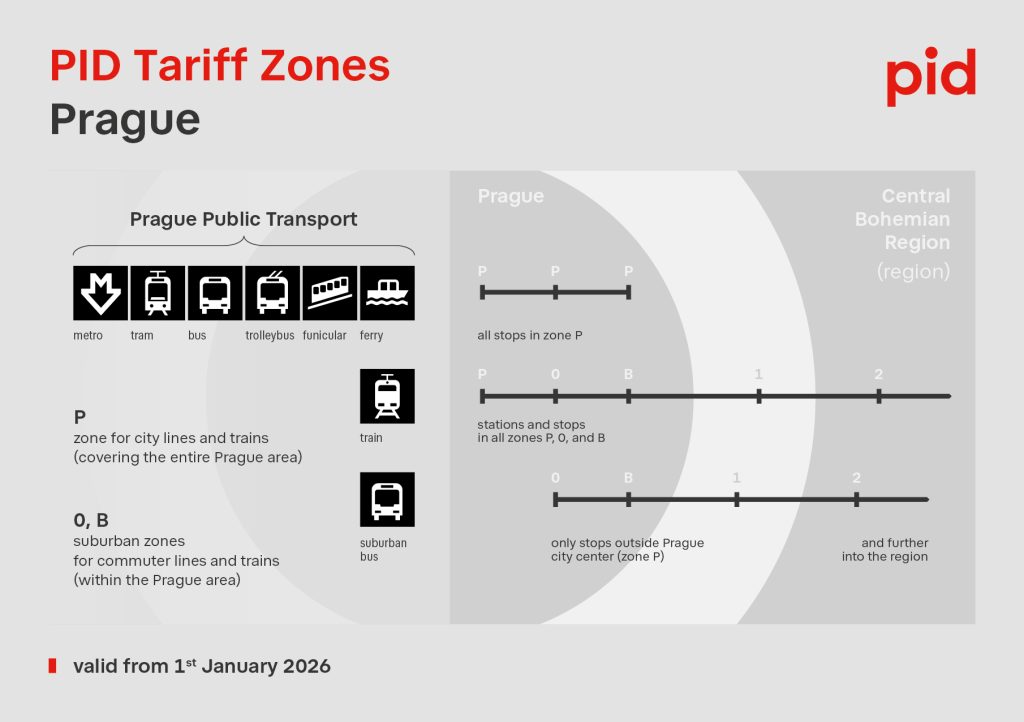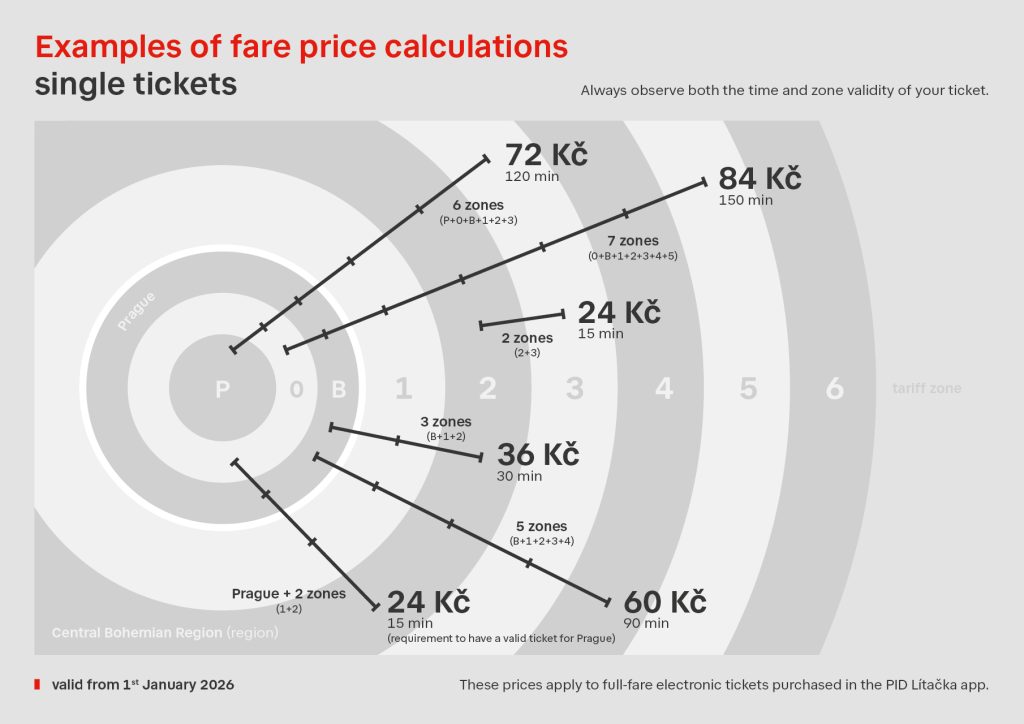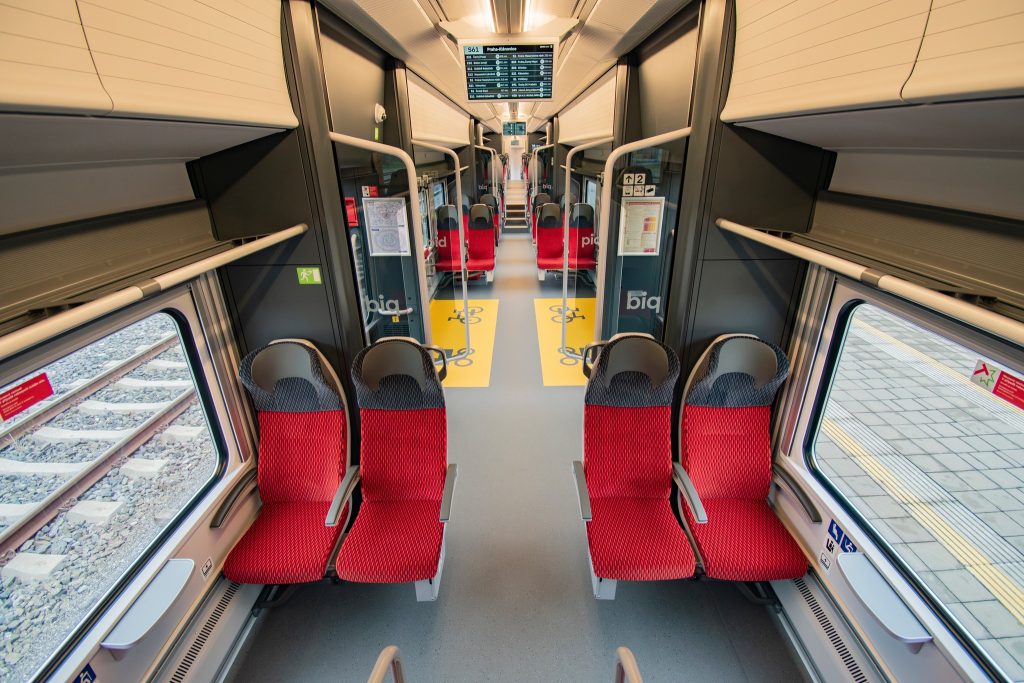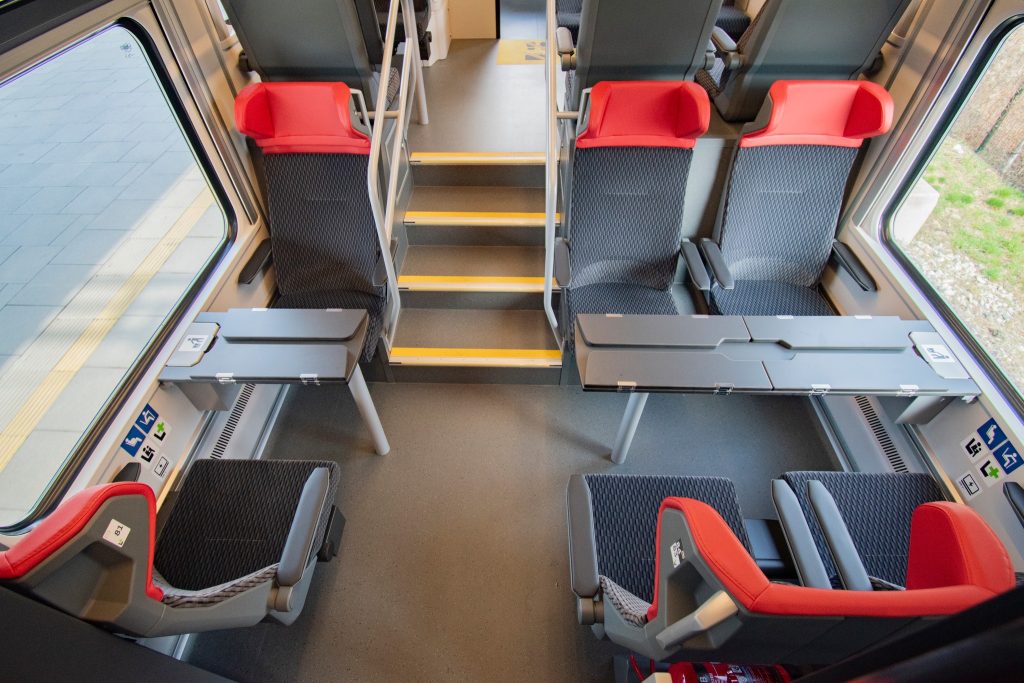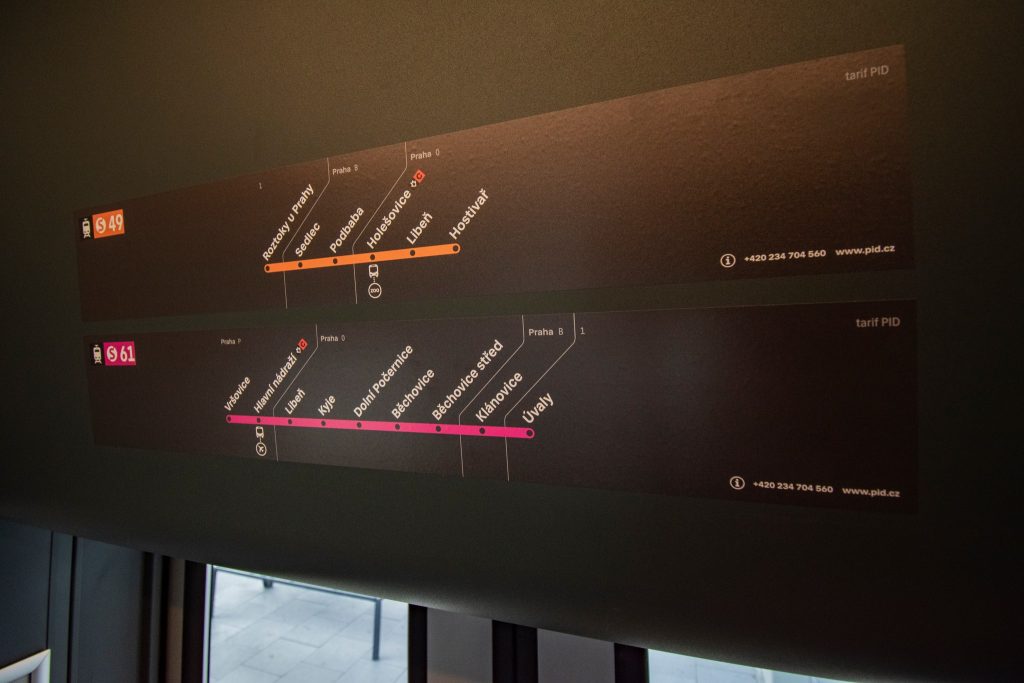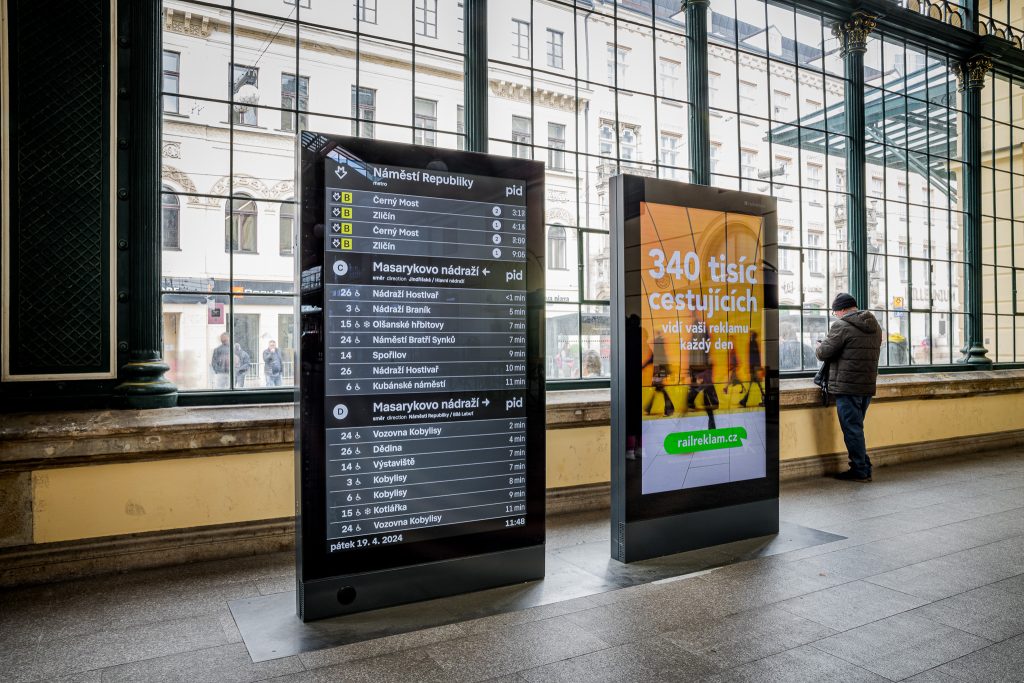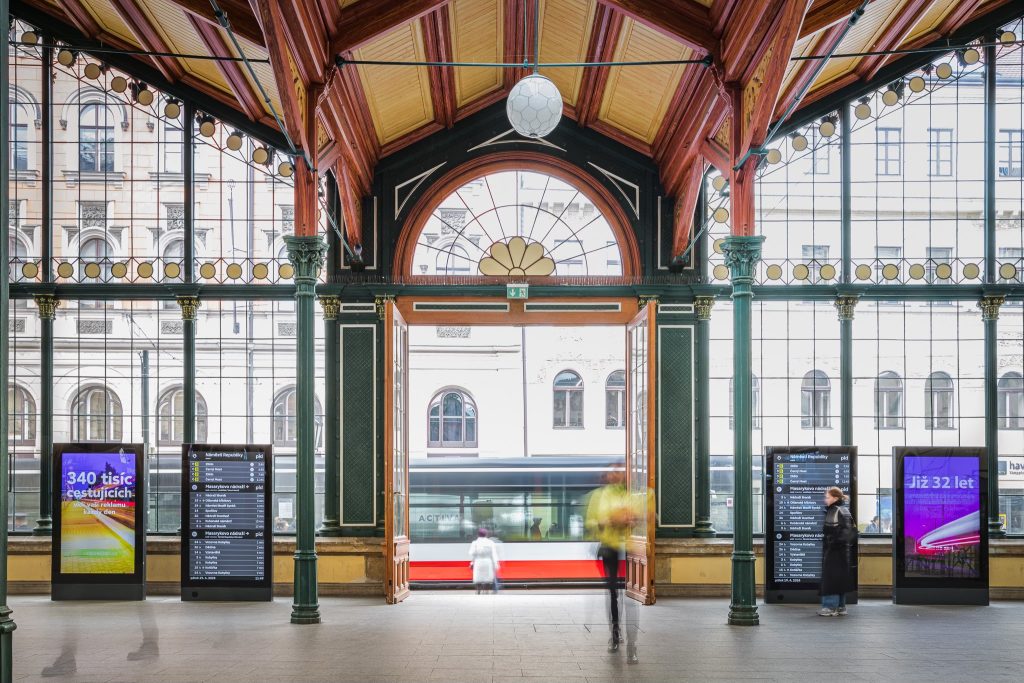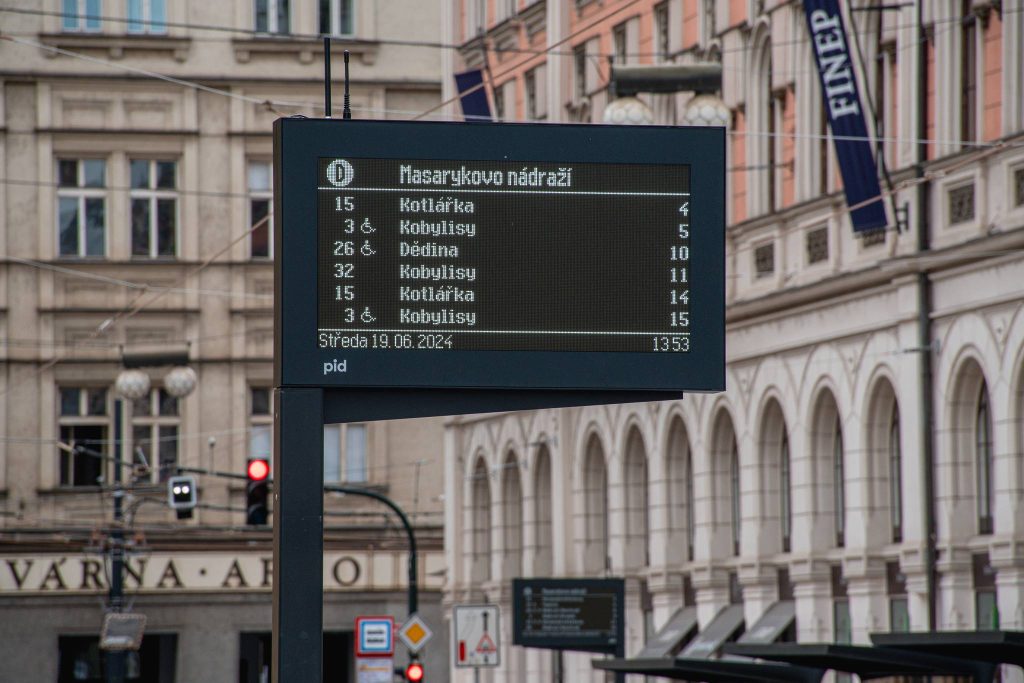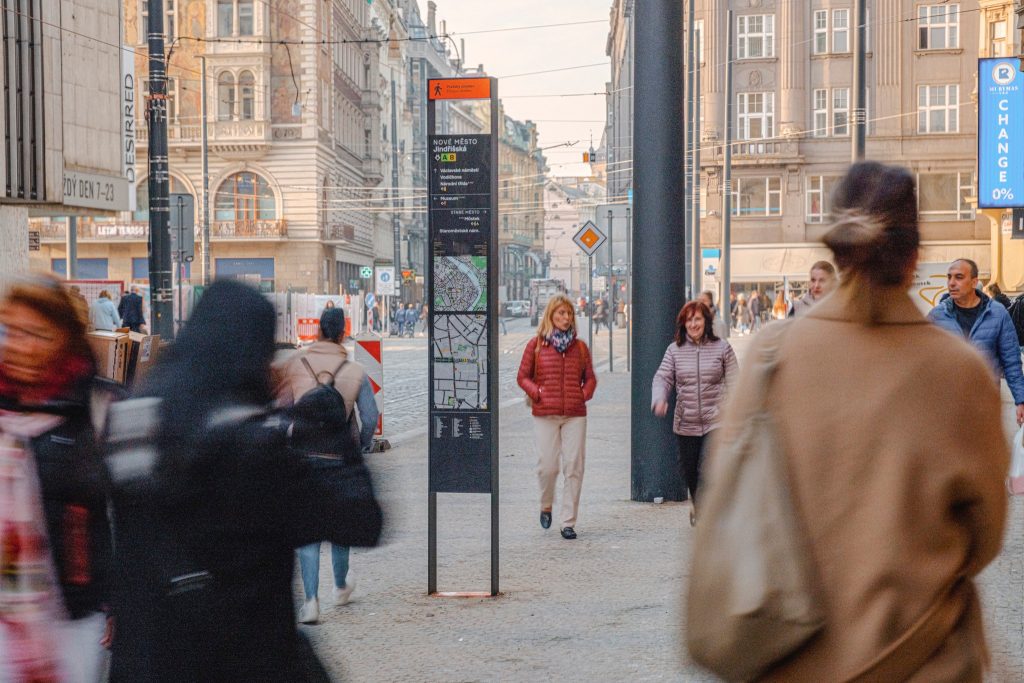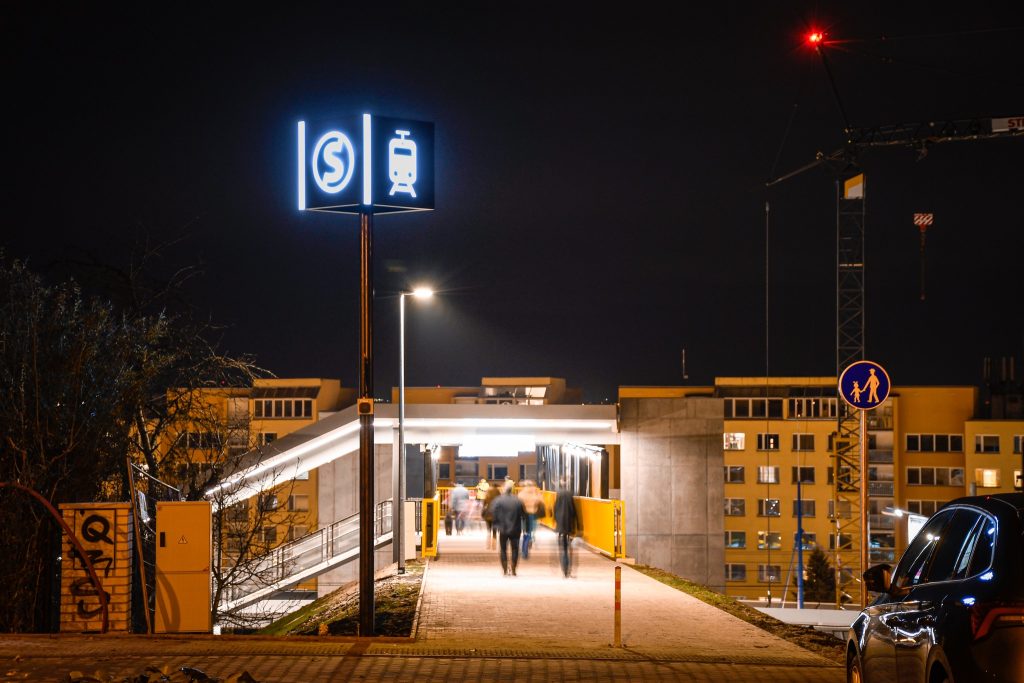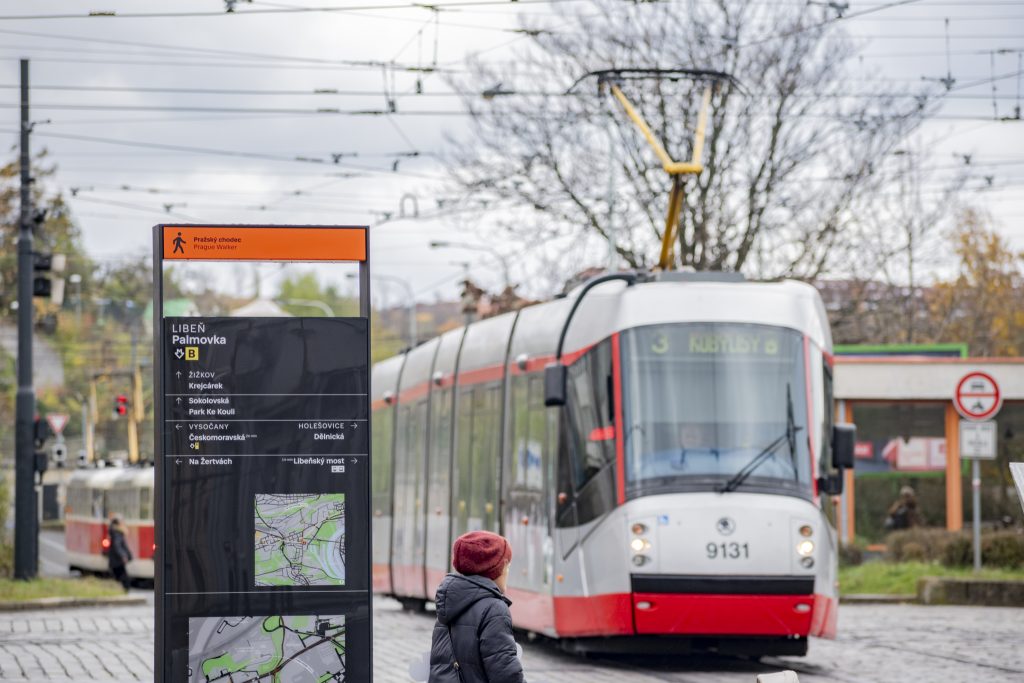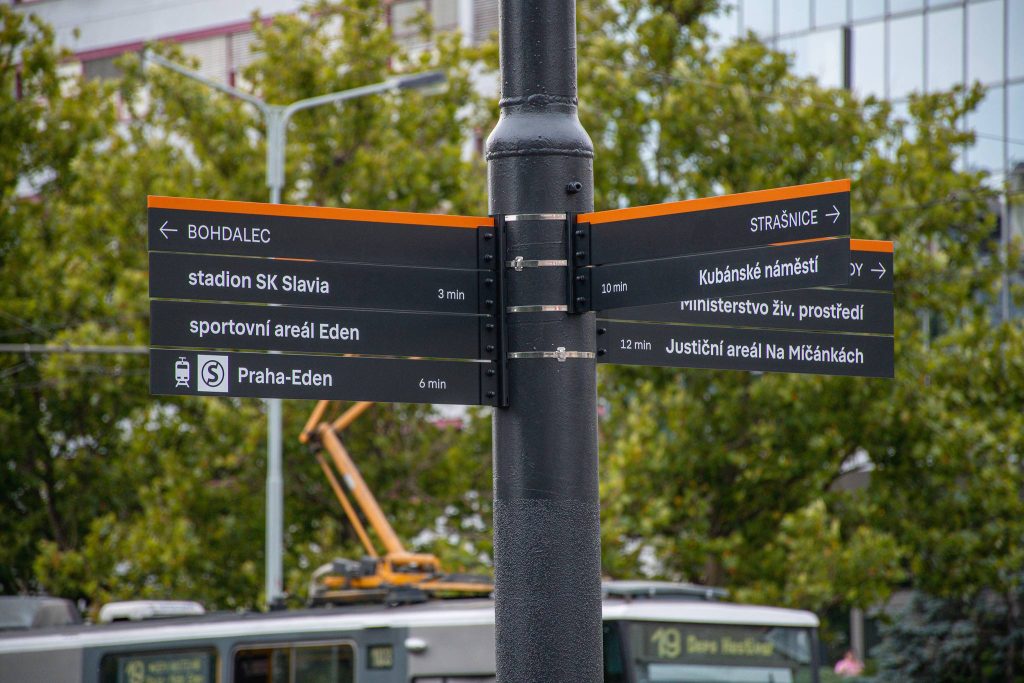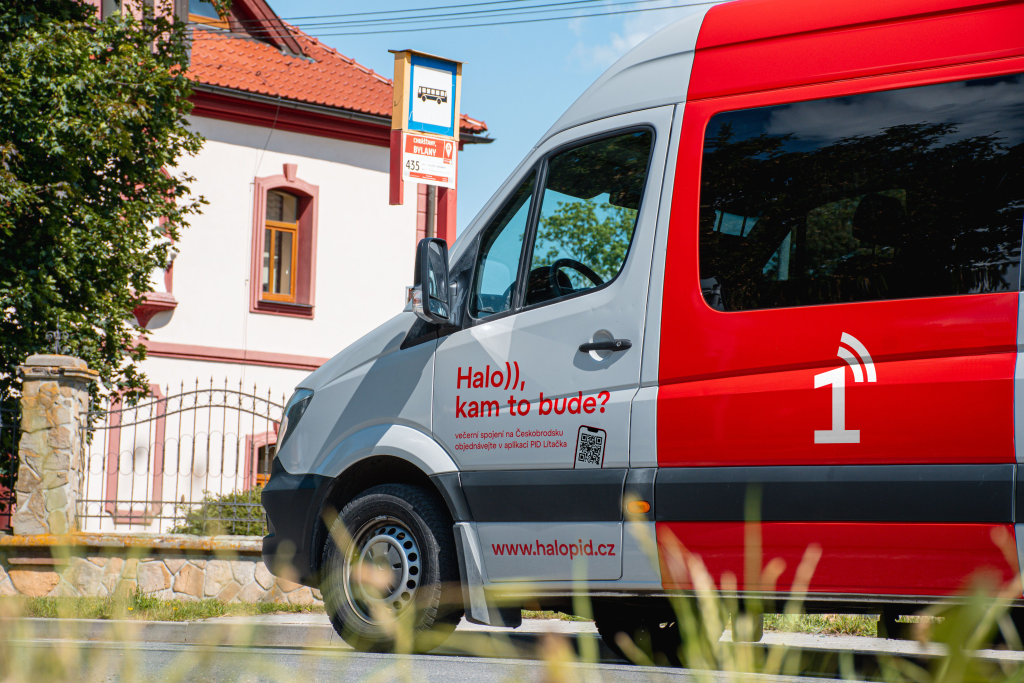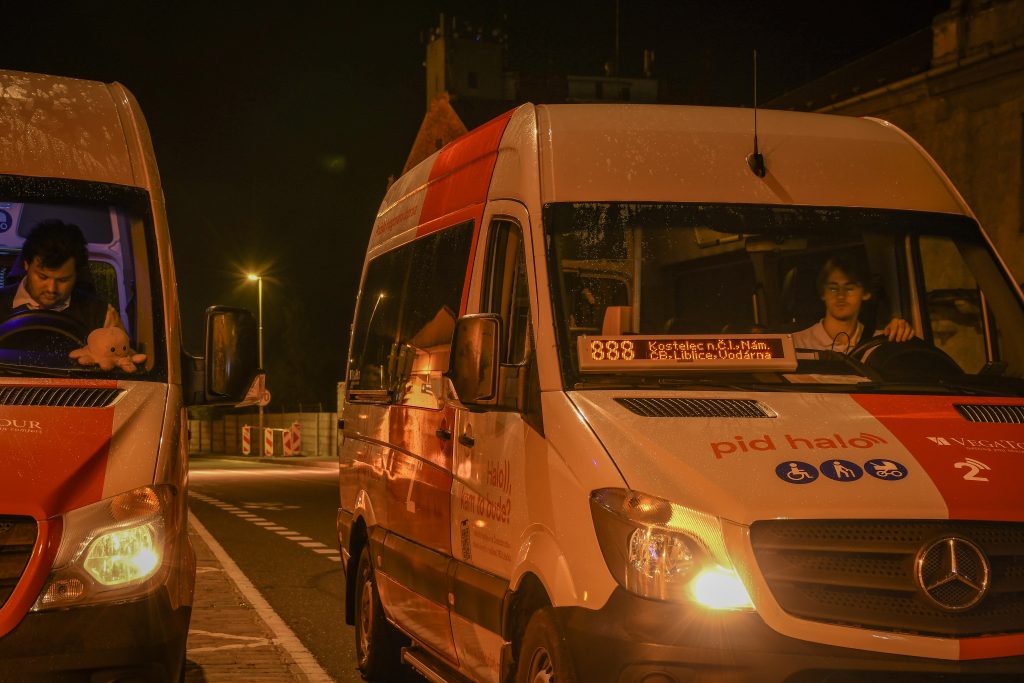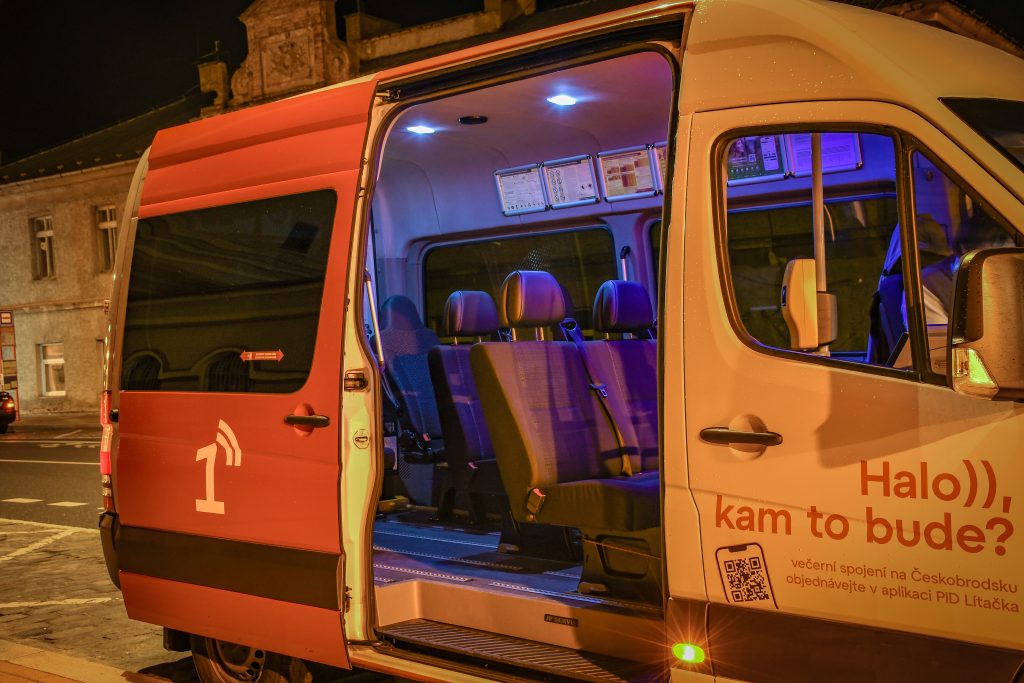Don’t forget to update the PID Litacka application for the new tariff valid from January 2026
The new tariff of Prague Integrated Transport (PID) will come into force on January 1, 2026. The changes mainly concern fares and make electronic purchases of tickets and subscription coupons even more advantageous, especially through the PID Lítačka application.
The aim of the new tariff is to motivate passengers to use modern, digital forms of check-in. Electronic fares are not only more convenient, but in 2026 they will also be the most advantageous option for traveling in the PID system.
In connection with the tariff changes, an update of the PID Lítačka application is being released these days, which contains the necessary adjustments resulting from the new tariff. In order for the application to function correctly from January 1, 2026, it is necessary to have the latest version installed.
Most mobile devices update automatically, but transport organizers recommend checking that the application is updated, especially at the end of the year. Users can find out whether the application is updated to the latest version in the Play Store or AppStore. If the application is not updated, the “Update” option is offered.
How do you know if you have an updated version of the app?
- You can check if an app update is available directly in the app store, where you normally download apps on your mobile phone.
iOS devices (App Store) – step by step
- Open the App Store.
- Tap the profile icon in the top right.
- Find the app in the Available Updates section.
- If you see “Update”, a new version is available and you need to update it; if you just see “Open”, you have the current version.
Android devices (Google Play) – step by step
- Open Google Play.
- Tap the profile icon in the top right.
- Select Manage apps and devices.
- Open Available Updates.
- If you see “Update”, a new version is available and you need to update it.
In 2026, electronic fares will be the most advantageous
The new PID tariff benefits passengers who purchase electronic tickets in the PID Lítačka application. These variants will be the cheapest in 2026 compared to paper and SMS tickets. The changes apply to both the capital city of Prague and the Central Bohemian Region.
In connection with the tariff changes, pre-sale of long-term subscription coupons was launched on December 1, 2025, valid from January 1, 2026. Passengers can purchase new travel documents through all PID sales channels – in the PID Lítačka mobile application, in the e-shop, at counters and with carriers.
The prices of long-term subscription coupons for Prague tariff zones remain unchanged, price adjustments only apply to external tariff zones.
What will happen to unused single-use tickets from 2025?
Single-use tickets purchased in the PID Lítačka application before or during December 2025 will be valid until December 31, 2025 at the latest. From January 1, 2026, these tickets will no longer be usable or presented at the check-in.
Unused tickets will be automatically moved to the application history and an automatic refund will be issued. The amount will be returned to the account from which the payment was made no later than the end of February 2026, more detailed information at: New PID Tariff from January 1, 2026: New PID Tariff from 1 January 2026: Don’t pay more than you have to | Pražská integrovaná doprava Pražská integrovaná doprava.
New PID Tariff from 1 January 2026: Don’t pay more than you have to
 From 1 January 2026, a new Prague Integrated Transport (PID) tariff will come into effect. The changes will mainly affect fare prices – there will be an increase in the price of single journey tickets in Prague and the outer zones, and also in the price of season tickets in the outer tariff zones. The price of season tickets within Prague will remain unchanged.
From 1 January 2026, a new Prague Integrated Transport (PID) tariff will come into effect. The changes will mainly affect fare prices – there will be an increase in the price of single journey tickets in Prague and the outer zones, and also in the price of season tickets in the outer tariff zones. The price of season tickets within Prague will remain unchanged.
There will be new benefits for purchasing travel documents via the PID Lítačka mobile app and for electronic season tickets for the outer zones through the e-shop: eshop.dpp.cz or www.pidlitacka.cz.
Prague will now be counted as 3 tariff zones (previously 4 zones), which will soften the impact of price increases for cross-border journeys between Prague and the Central Bohemian region. The new tariff also brings several changes to rail transport and an increase in surcharges for travelling without a valid ticket. The range of discount categories remains unchanged.
New ticket prices in Prague
The main change is the increase in the price of single tickets and their discount when purchased through the PID Lítačka app.
Tourist tickets for 24 and 72 hours will also become more expensive, and it will also be more advantageous to buy these electronically.
Single fare in Prague (basic fare*)
| Short-term tickets | PID Litacka – mobile application | Paper ticket |
|---|---|---|
| 30 min. | 36 CZK | 39 CZK |
| 90 min. | 46 CZK | 50 CZK |
| 24 hours | 140 CZK | 150 CZK |
| 72 hours | 340 CZK | 350 CZK |
*Full fare | From 15 to 60 years old
Single fare in Prague (discounted fare*)
| Short-term tickets | PID Litacka – mobile application | Paper ticket |
|---|---|---|
| 30 min. | 18 CZK | 19 CZK |
| 90 min. | 23 CZK | 25 CZK |
| 24 hours | 70 CZK | 75 CZK |
| 72 hours | This option is not available. | This option is not available. |
* Half price| Seniors from 60 years until 65 years bearing a valid proof of their discount entitlement.
Subscription tickets for Prague (remains unchanged)
| Long-term tickets | Full price | Half price |
|---|---|---|
| One month | 550 CZK | 130 CZK |
| Three months | 1 480 CZK | 360 CZK |
| Annual | 3 650 CZK | 1 280 CZK |
Full price| From 18 until 60 years
Half price| Adolescents from 15 until 18 years, Students from 18 to 26 years (only full-time students of high schools and colleges bearing a valid study certificate) a Seniors from 60 until 65 years.
New prices in the Central Bohemian region
Similarly to Prague, the prices of single and 24-hour tickets are increasing. The price rise is approximately 30% for paper tickets and 20% for tickets in the PID Lítačka mobile application.
Unlike in Prague, there will also be an increase in the prices of long-term passes for the outer tariff zones – again by about 30% (paper) and 20% (electronic).
A new 4-zone 24-hour ticket will now be valid for any four consecutive outer zones (previously only for zones 1–4) and will only be available in electronic form.
Single fare in the region
| Full price * | Half-price** | ||||
|---|---|---|---|---|---|
| Number of zones | Time of validity | PID Litacka | Paper ticket | PID Litacka | Paper ticket |
2 zones   |
15 min. | 24 CZK | 26 CZK | 12 CZK | 13 CZK |
| 3 zones | 30 min. | 36 CZK | 39 CZK | 18 CZK | 19 CZK |
| 4 zones | 60 min. | 48 CZK | 52 CZK | 24 CZK | 26 CZK |
| 5 zones | 90 min. | 60 CZK | 65 CZK | 30 CZK | 32 CZK |
| 6 zones | 120 min. | 72 CZK | 78 CZK | 36 CZK | 39 CZK |
| 7 zones | 150 min. | 84 CZK | 91 CZK | 42 CZK | 45 CZK |
| 8 zones | 180 min. | 96 CZK | 104 CZK | 48 CZK | 52 CZK |
| 9 zones | 180 min. | 108 CZK | 117 CZK | 54 CZK | 58 CZK |
| 10 zones | 180 min. | 120 CZK | 130 CZK | 60 CZK | 65 CZK |
| 11 zones | 180 min. | 132 CZK | 143 CZK | 66 CZK | 71 CZK |
| 12 zones | 180 min. | 144 CZK | 156 CZK | 72 CZK | 78 CZK |
| 13 zones | 180 min. | 156 CZK | 169 CZK | 78 CZK | 84 CZK |
| 14 zones | 180 min. | 168 CZK | 182 CZK | 84 CZK | 91 CZK |
| 15 zones | 180 min. | 180 CZK | 195 CZK | 90 CZK | 97 CZK |
| 16 zones | 180 min. | 192 CZK | 208 CZK | This option is not available. | This option is not available. |
| Prague and zones 1-4 | 24 hrs. | 192 CZK | 210 CZK | This option is not available. | This option is not available. |
| Zones 1-4 | 24 hrs. | 96 CZK | This option is not available. | 48 CZK | This option is not available. |
| Regional (zones 1-13) | 24 hrs. | 168 CZK | 185 CZK | 84 CZK | 92 CZK |
| Whole network | 24 hrs. | 288 CZK | 315 CZK | This option is not available. | This option is not available. |
* Full price | From 18 until 60 years
** Half price | Children from 6 to 10 years, Children from 10 to 15 years, Adolescents from 15 to 18 years, Students from 18 to 26 years and Seniors from 65 years, bearing a valid proof of their discount entitlement.
Change in the calculation of zones for journeys beyond the borders of Prague
From 2026, Prague will be counted as 3 fare zones for cross-border travel instead of the previous four. Zone P will now be counted as only one zone (originally as two zones). For example, a trip from the 1st outer zone to the center of Prague (zone P) will now only require a ticket for 4 zones (zones P, 0, B and 1) instead of the original five-zone ticket. Zones 0 and B remain unchanged.
Attention! The change in the zone calculation applies only to passengers who buy individual fares from/to outer zones (1-13), which also includes travel on Prague public transport (zone P). The zone calculation does not change for passengers who buy a fare only for Prague public transport, or individual fares from/to outer zones to/from travel zones 0 and/or B.
The zone calculation does not change for passengers who use subscription coupons either.
Regional fare subscription
Subscription tickets in the Region - Full price
Subscription tickets in the Region - Half price
By train as public transport
The new tariff also unifies the rules for travelling by train in Prague (zones P, 0, B) with the rules valid for public transport. Most of the existing exceptions will be abolished.
Main news:
- Extension of free travel on trains in Prague for a person accompanying a child under 3 years of age.
- Dogs travel free in Prague – with a valid PID ticket, it will now be possible to transport a dog in Prague without an extra charge.
- Large luggage free with a season ticket in Prague – with a 24-hour ticket for Prague or a season ticket for Prague, it will be possible to transport one large piece of luggage free of charge.
- Simplification of proving entitlement to a discount on trains in Prague – children aged 6–15 and seniors from 65 years will no longer need a special PID card on PID trains, an official verified document or identity card will be sufficient, as is already the case on public transport.
- The conditions for proving entitlement to student fares remain unchanged.
Increase in price for luggage or dog
The price for transporting large luggage or a dog is increasing:
- 23 CZK in electronic form
- 25 CZK in paper form
Increase in fare on the Airport Express (AE) line
Passengers on the line from the Main Railway Station to Václav Havel Airport Prague will now pay 200 CZK (children aged 6–15 years 100 CZK).
Regular public transport lines can still be used within the standard PID tariff.
Group (family) fares in the Central Bohemian region
Completely new group (family) one-day tickets will be introduced for all outer tariff zones, valid until 4:00 the following day. They will be sold in two variants:
| Group composition | Validity | Price in the app | Price of a paper ticket |
| 1 adult + max. 2 children up to 15 years | 1 den (do 4:00 následujícího dne) | 190 CZK | 210 CZK |
| 2 adults + max. 4 children up to 15 years old | 1 den (do 4:00 následujícího dne) | 370 CZK | 400 CZK |
Note: These tickets are valid only in the outer zones of PID, not within the territory of Prague.
Increase in fare surcharges
In the territory of Prague (zones P, 0, B)
Surcharge for travelling without a valid ticket:
- 1,200 CZK (on the spot)
- 1,500 CZK (within 15 days)
- 2,000 CZK (other cases)
Reduced surcharge for subsequent proof of a season ticket or entitlement to a discount or entitlement to special fare or entitlement to free transport within 15 days:
- 50 CZK
Surcharge for unpaid fare for a dog or luggage:
- 200 CZK (on the spot)
- 400 CZK (within 15 days)
- 600 CZK (other cases)
Surcharge for other breaches of statutory obligations and transport conditions:
- 1,000 CZK (on the spot)
- 1,500 CZK (within 15 days)
- 2,000 CZK (other cases)
In the Central Bohemian Region (surcharge increase already implemented from 1. 8. 2025)
Surcharges for travelling without a valid ticket:
- 1,500 CZK (on the spot)
- 2,000 CZK (within 15 days)
- 2,500 CZK (other cases)
Reduced surcharge for subsequent proof of a season ticket or entitlement to discounted fare or free transport within 15 days:
- 100 CZK
Surcharge for unpaid fare for a dog or luggage:
- 200 CZK (on the spot)
- 400 CZK (within 15 days)
- 600 CZK (other cases)
Surcharge for other breaches of statutory obligations and transport conditions:
- 1,000 CZK (on the spot)
- 1,500 CZK (within 15 days)
- 2,000 CZK (other cases)
Note: If a passenger is found with a forged ticket, an imitation ticket, an altered or modified ticket, the surcharge reduction is not granted. The surcharge is also not reduced in cases where a ticket used by another person is presented.
Sale and return of tickets
Single tickets valid from 1. 1. 2026 will be available in advance sale in December 2025, in ticket machines and in the app from 1. 1. 2026.
Season tickets valid from 1. 1. 2026 can be purchased from 1. 12. 2025.
Return of paper tickets:
- From January 1, 2026, it will no longer be possible to use single-use tickets purchased according to the old price list.
- Redemption takes place from January 2, 2026 to January 31, 2026 at all sales points of the Prague Public Transport Company (except for Infocenters, which will not redeem tickets), up to a maximum of 5 tickets of one nominal value.
- More than 5 tickets of one nominal value can be redeemed only at the Central Dispatch Center, Na Bojišti 5, Prague 2, hall – counter no. 9.
- From February 1, 2026 to June 30, 2026, it will be possible to return tickets only at the Central Dispatch Center, Na Bojišti 5, Prague 2, hall – counter no. 9.
- The redemption applies only to unmarked (unused) PID paper tickets.
Expiration of old tickets purchased in the PID Lítačka application and refund:
- Tickets according to the old price list will be automatically invalidated and moved to the History section in the application. It is not necessary to request a refund, the amount for unused tickets will be automatically sent back to the account from which they were purchased.
- Changes and refunds do not apply to bicycle tickets.
- In cases where it is not possible to automatically refund the payment for technical reasons, registered users will be contacted directly by Operátor ICT via the e-mail that was entered during registration.
- If you use the application without registration and your payment is not refunded by the end of February 2026, please contact the application support exclusively at info@pidlitacka.cz. Include the ticket identification and bank account number in the message.
- The refund process is technically provided and administered by Operátor ICT, a.s – the operator of the PID Lítačka application. The deadline for processing refunds ends on June 30, 2026.
Boarding through all doors: New in PID suburban buses from August 2025
From August 1, 2025, passengers in the Central Bohemian Region and Prague will face a fundamental change in check-in on suburban bus lines of the PID system. Boarding through all doors will now be possible on almost a hundred daytime and ten night lines.
What is changing?
- Expansion of the boarding through all doors regime to another 99 daytime and 10 night lines of the PID.
- The new regime follows on from the current test operation on 9 regional lines.
- It mainly concerns lines from Prague to surrounding municipalities that have more stops in the capital.
Benefits for passengers
- Faster boarding – less queues at the front door.
- Possibility of boarding through any door if you have a valid ticket (paper or electronic).
- Shorter travel times, especially during rush hour and therefore less delays.
- Still possible to buy a ticket from the driver (but boarding through the front door is required).
- Friendlier transport that can also appeal to new passengers.
Which lines are affected by the change?
- Daytime suburban lines: 300–429 (except lines 305, 315, 345, 389, 392, 393, 395, 400–407, 410, 412, 413, 415–417, 420–428)
- Regional lines with already established regime: 481, 484, 519, 705, 785, 801, 805, 823, 858
- Night lines: 951–961
How do you know that you can board through all doors?
- The affected lines will be marked in the timetables, the PID Lítačka mobile application and connection search engines with the note BOARDING THROUGH ALL DOORS.
- Buses on these lines will be marked with a sign behind the front window and on the side of the door with information about the boarding mode through all doors.
- An information campaign will be carried out in the media and on social networks before the change is launched.
What do you have to do?
- Do you have a valid ticket? You can board through any door.
- Don’t have a ticket? Board through the front door and buy one from the driver.
- Expect more frequent inspector checks on these lines.
Practical tips for traveling safely
- Have your ticket ready before boarding – on paper or in the PID Lítačka (this ticket must already be activated when boarding). The paper ticket must be marked immediately after boarding, if it is not already marked
- Make your journey easier and use the mobile application – faster check-in, convenient connection search.
- You can download the mobile application here: PID Lítačka: One application, thousands of options
- Board responsibly – your fare discipline will also decide on the continuation of the new system and its expansion.
- Avoid fines – don’t expect the inspector not to come. He will come. Please note, from August 1, 2025, surcharges for traveling without a valid ticket will increase significantly in the Central
- Bohemian Region: CZK 1,500 on the spot, CZK 2,000 within 15 days by transfer to an account or in a supplementary payment slip, or CZK 2,500 after this period has expired.
What’s next?
The trial mode will run until the end of 2026.
The continuation or expansion will be decided mainly by the behavior of the passengers themselves (whether they pay the fare properly). If the system does not prove successful, boarding through all doors may be canceled even earlier.
Conclusion
The introduction of boarding through all doors is a significant step towards modern, efficient and comfortable suburban transport. However, the success of this change also depends on each of us – being considerate, paying the fare and respecting the rules is the best thing we can do for the smoothness, speed and comfort of public transport.
Frequently Asked Questions (FAQ): Boarding through all doors in PID suburban transport
1. Since when is the new feature being introduced?
2. What does 'boarding through all doors' mean?'
3. Can I still buy a ticket from the driver?
4. What if I have a ticket in the mobile app?
5. How do I know that my line now allows boarding through all doors?
6. Why is boarding through all doors not available on all lines?
7. Can I board through the back door even if I don't have a ticket??
8. How do I secure a seat now? Until now, it was enough to arrive at the bus stop in advance and be at the front of the queue.
9. Ticket checks will be more frequent?
10. How much will I pay if I travel without a valid ticket??
11. Why is this system being introduced?
12. Is it permanent??
13. What happens if many people don't buy tickets??
New train line S61 starts on April 1st with new trains
From April 1, 2025, a new train line S61 will operate on the route Prague-Vršovice – Prague hl. n. – Prague-Libeň – Prague-Běchovice – Úvaly. The new line and the existing line S49 from Prague Hostivař to Roztok u Prahy will be equipped with new electric low-floor units Pesa Elf.eu operated by the newly tendered carrier RegioJet.
The train line S61 will operate on the route Prague hlavní nádraží – Prague-Libeň – Prague-Kyje – Prague-Dolní Počernice – Prague-Běchovice – Prague-Běchovice střed – Prague-Klánovice – Úvaly. The line will operate on weekdays at intervals of 30 minutes, on weekends it will run every hour and will run from the main station to Vršovice. Due to the introduction of the S61 line, some connecting bus lines departing from Klánovice and Úvaly will also be adjusted.
„Modern barrier-free electric units on city lines will bring a further significant increase in quality for rail passengers in Prague and the surrounding area. We are currently examining other options for rail connections on city lines in Prague, in order to offer passengers fast, capacious and attractive connections to other parts of the capital without the need for transfers. In cooperation with the Railway Administration, the Prague 14 city district and city organizations, we are also intensively addressing the construction of the designed stops in Prague 14 for the S61 train line. Their construction has been suspended for the time being due to the examination of related investment plans in the Prague railway hub. The possible construction of railway stops will of course be in coordination with the planned modernization of the affected line and the recently approved ‘metro S’ plan, i.e. new underground lines and stations, which are very important for the further development of the capital,” says Zdeněk Hřib, 1st Deputy Mayor of Prague for Transport.
„This new S61 line will once again provide residents of Úval with a direct connection to Prague’s main railway station, making it easier for them to travel to work or study,” said Petr Borecký, councilor of the Central Bohemian Region for public transport.
Alternative route will help busy lines between Prague and Úvaly
The new S61 train line was originally supposed to run on the route Prague-Vršovice – Prague-Zahradní Město – Prague-Běchovice, including the new stops Jahodnice, Hostavice and Jiráskova čtvrť. The project preparation of the new stops, which is now nearing completion, was carried out by the Prague 14 district. Their implementation is currently suspended because it could clash with the current plan for the reconstruction of the Prague railway junction and the planned capacity expansion of the line on which the new stops were to be located. „However, since the new S61 line makes no sense without the new stops, an alternative route was chosen that will help relieve the busy lines between the center of Prague, Libení, Běchovice and Úvaly. The alternative route will also replace the missing direct connection of the line to Úvaly with Prague’s Main Station after the S7 line in the direction from Beroun was shortened,” says ROPID director Petr Tomčík.
„I welcome the increase in capacity on the connection between Prague and Úvaly, which is currently one of the busiest in the PID system network,” said Zdeněk Šponar, director of IDSK.
New modern trains for lines S61 and S49
New three-car electric units from the Polish manufacturer Pesa will also run on the existing urban train line S49 from Prague-Hostivař via Libeň and Holešovice to Roztok u Prahy from 1 April 2025. Lines S49 and S61 will be operated by RegioJet, which won the competition to operate these lines in 2021. The new units were originally scheduled to start operating in December 2024, but there were delays due to delayed delivery of vehicles from the manufacturer.
The new trains, with a capacity of 231 seated passengers, are barrier-free accessible, air-conditioned, equipped with electrical outlets and wifi, with large-capacity spaces for bicycles and strollers, and in a uniform grey-red PID paint. The internal digital information system in the new Readable Prague graphics will offer, in addition to standard route information, online information about possible transfers to other PID lines at the current stop. There will also be a 1st class compartment on the trains, where it will be possible to buy a one-time supplement directly from the train crew. On lines S49 and S61, only the PID tariff and the state-wide One Ticket tariff will apply.
Readable Prague and the year 2024
The project of the unified information and navigation system Readable Prague advanced to the next phase in 2024. We significantly expanded the number of digital information panels at important surface transport stops, we fine-tuned the appearance of maps on obelisks to fundamentally strengthen pedestrian navigation, which we are testing in various places in Prague in various sizes. Extensive user research was also carried out in the metro and at tram stops – for example, new traffic patterns in metro cars, the so-called dachshunds, took their final form. We are also piloting new navigation elements on the railway, which help to better integrate trains into urban public transport.
Together with the authors of the new unified design and individual project stakeholders, we are now finalizing a detailed navigation manual in the Prague metro or tuning the new form of the content of digital screens, information materials, traffic patterns, or stop timetables. We are also gradually fine-tuning the new final form of carriers for individual information, such as stop markers, directional signs in the metro, or information display cases.
What was achieved in 2024
- 30 separate departure panels at major tram and bus stops
- 45 departure panels in new stop shelters (implemented by THMP)
- new large-screen departure screens at Masaryk Station
- third metro test station: Chodov (new navigation sign graphics)
- further test prototypes of new markers at Staroměstská and Nádraží Libeň
- navigation signs within the new footbridge to the Prague-Rajská zahrada train stop (as part of the full operation of the footbridge)
- new totems to highlight metro and railway stations: Malostranská, Háje, Eden, Rajská zahrada, Dolní Počernice
- pilot project of railway navigation – Prague-Dolní Počernice stop
- user testing of a new form of information at surface transport stops at Palmovka, the so-called “lenses” and the content of new information display cases in stop shelters
- finalization of the final form and full-scale installation of new metro schemes in cars, the so-called “dachshunds”, user testing of navigation elements in metro stations
- new obelisks for pedestrian navigation on Wenceslas Square, Palmovka, Štvanice, Strossmayer Square or near the Veletržní Palace
- new prototypes of direction signs for pedestrian navigation in Eden or Štvanice
What we expect in 2025
In 2025, we expect the gradual implementation of totems, or elements highlighting individual metro or railway stations, at individual selected locations. Furthermore, the plan is to fine-tune and gradually replace static information at surface transport stops, so-called “lenses”, including the installation of information display cases in shelters. The installation of dozens more digital departure panels at public transport stops will also continue, either in the form of free-standing panels or screens in shelters. Regarding pedestrian navigation, the plan is to equip a comprehensive route connecting Prague 1 and 7 with new signposts and obelisks, so that we can set up an overall system for the deployment of these elements on the streets of Prague to make pedestrian movement more attractive and better distribute visitors to the metropolis from the main tourist routes to other parts of Prague. We would also like to fine-tune a new family of stop markers, new carriers of static information in the metro, or information display cases. This year’s plan also includes gradual modifications to the PID Lítačka mobile application, as the main electronic traffic navigation tool.
The mobile application in conjunction with navigation and information directly in the field is the key to a truly comprehensive and unified system.
User testing of new elements will continue in order to fine-tune their final form and to begin the nationwide exchange of individual types of elements or information materials. The project also aims to expand the new form of information about public transport to the territory of the Central Bohemian Region within the PID system.
We are cooperating on the project in particular with the Prague Public Transport Company, the Prague Planning and Development Institute, Prague Technologies, the Prague Technical Communications Administration, Prague City Tourism, but also with the Central Bohemian Region and the Railway Administration.
PID operation during the Christmas and New Year holidays
During this year’s Christmas and New Year’s holidays and vacations, the operation of public transport in Prague and the Central Bohemian Region will be adjusted as usual. On Christmas Day, PID will run according to the Saturday timetable, with the end of the daily tram and bus service at approximately 18:00. The metro will run until midnight, but in the evening at extended intervals. From 25 to 26 December 2024 and 1 January 2025, PID will operate according to Sunday timetables. On working days, i.e. On December 23, 27, 30, 2024 and January 2 and 3, 2025, PID will run according to the holiday timetables. On New Year’s Eve, the PID will run according to the holiday timetables, with adjusted operation in the evening and with extended operation.
Monday, December 23, 2024
Public transport operation in Prague according to the holiday timetables valid for the working day. During this period, tram lines 4 and 21 will not be in operation, line 16 will run only in the section of DP Central Workshop – Kotlářka, student bus line 187, student interleaved connections of line 177 on the route Chodov – Volha, and school lines and school connections of suburban lines will not run either . Holiday timetables will apply on selected suburban lines. Trains will run according to the timetables for a normal working day with possible minor restrictions on selected connections.
Tuesday 24 December 2024 (Christmas Day)
PID will run on Christmas Day this year according to the Saturday holiday timetable. The metro will run according to the Saturday timetable until approx. 18:00, then it will run at intervals of 20 minutes until approx. midnight. The daily operation of trams, buses and ferries will end at approximately 18:00. Airport line 59 will follow the metro until the end of its operation. Bus lines primarily serving shopping centers (180, 191, 208, 228, 246) will also run according to special timetables. Lines 143, 187 and 238 will not be in operation.
Night services will depart at approximately 6:00 p.m. and will be in operation until approximately 7:00 a.m. the next day. During metro operation, line 904 will go to Zličín metro station, line 908 to Skalka metro station, lines 911 and 916 to Letňany metro station and line 911 to Roztyly metro station. Selected night suburban lines will run according to special timetables.
Suburban bus lines will run according to Saturday timetables and their evening operation will be modified by the relevant time notes in the timetables.
Train operation according to Sunday or holiday timetables will be terminated between 6:00 p.m. and 8:00 p.m., with the fact that operations will be maintained on selected backbone lines S until approximately 10:00 p.m. The operation of line S49 will be terminated approximately at 5:00 p.m. The midnight departure of trains from Prague will also be cancelled.
Wednesday 25 December 2024 (Christmas Day 1)
PID operation according to the Sunday holiday timetables, with the fact that the daily operation of trams, city and selected suburban buses will start from approximately 7:00 a.m., with the exception of line 59, which will depart following the start of metro operation. During the metro operation, selected night lines will return to selected metro stations in the same way as on Christmas Day. Lines 143, 187, 238 and inserted student connections of line 177 to the Volga will not be in operation. Bus lines primarily serving shopping centers (180, 191, 208, 228, 246) will also run according to special timetables. Trains will run according to the timetables for Sunday or holiday with possible minor restrictions on selected connections. Train line S49 will not start operating until approximately 7:00 a.m.
Thursday 26 December 2024 (2nd Boxing Day)
PID operation according to Sunday holiday timetables. Lines 143, 187 and inserted student connections of line 177 on the Volga will not be in operation. Bus lines primarily serving shopping centers (180, 191, 208, 228, 246) will also run according to special timetables. Trains will run according to the timetables for Sunday or holiday with possible minor restrictions on selected connections.
Friday, December 27, 2024
Public transport operation in Prague according to the holiday timetables valid for the working day. During this period, tram lines 4 and 21 will not be in operation, line 16 will run only in the section of DP Central Workshop – Kotlářka, student bus line 187 will not run, student connections of line 177 on the route Chodov – Volha will not run, and school lines and school connections of suburban lines will not run either . Holiday timetables will apply on selected suburban lines. Trains will run according to the timetables for the working day with possible minor restrictions on selected connections.
Saturday, December 28, 2024
PID operation according to Saturday holiday timetables. Student lines 143, 187 and inserted student connections of line 177 to the Volga will not be in operation.
Sunday, December 29, 2024
PID operation according to Sunday holiday timetables. Student lines 143, 187 and inserted student connections of line 177 to the Volga will not be in operation.
Monday, December 30, 2024
Public transport operation in Prague according to the holiday timetables valid for the working day. During this period, tram lines 4 and 21 will not be in operation, line 16 will run only in the section of DP Central Workshop – Kotlářka, student bus line 187 will not run, student connections of line 177 on the route Chodov – Volha will not run, and school lines and school connections of suburban lines will not run either . Holiday timetables will apply on selected suburban lines. Trains will run according to the timetables for the working day with possible minor restrictions on selected connections.
Tuesday, December 31, 2024 (New Year’s Eve)
Public transport operation in Prague according to the holiday timetables valid for the working day. The metro will run with extended operation so that the last connections pass through the center of Prague on the second day just after 2 am. Tram lines 4 and 21 will be out of service, line 16 will run only in the DP Central Workshop – Kotlářka section. The daily operation of trams and buses will end at approx. 22:00, with the fact that selected bus lines (59, 102, 103, 106, 107, 109, 111, 112, 113, 118, 120, 123, 125, 126, 129, 131, 134, 136, 137, 139, 141, 142, 145, 153, 154, 159, 161, 162, 163, 174, 176, 177, 180, 190, 191, 193, 197, 199, 201, 207, 215, 221, 226, 227, 229, 241; some lines only on part of the regular route) according to special timetables. Bus lines primarily serving shopping centers (180, 191, 208, 228, 238 and 246) will also run according to special timetables.
Student bus line 187, inserted student connections of line 177 on the route Chodov – Volha, and school lines and school connections of suburban lines will not run either.
The operation of night trams will start at approximately 10:00 p.m. at 15-minute intervals on all lines until approximately 3:30 a.m. the next day, after which all lines will switch to an interval of 20 minutes and will operate until approximately 7:00 a.m. the next day. Guaranteed transfers are cancelled.
Night bus lines (lines 904, 905, 910, 911 in a shorter interval) will depart on the second day at approximately 2:30 a.m. and will be in operation on the second day until approximately 7:00 a.m. During metro operation, line 904 will go to Zličín metro station, line 908 will go to Skalka metro station, lines 911 and 916 to Letňany metro station and line 911 to Roztyly metro station. Selected night suburban lines will run according to special timetables. Guaranteed transfers are cancelled.
Holiday timetables will apply on selected suburban lines and their evening operation will be modified by the relevant time notes in the timetables.
Trains will run according to the holiday timetables for the working day and the operation will end at approx. 20:00 with the fact that until approx. 22:00 to 23:00 the operation will be maintained at an interval of 60 minutes on all S lines (from/to Prague). The operation of line S49 will end at approximately 19:00. The midnight departure of trains from Prague will also be cancelled.
Wednesday 1 January 2025 (New Year’s Day)
PID operation according to the Sunday holiday timetables, with the fact that the daily operation of trams, city and selected suburban buses will start from approximately 7:00 a.m., with the exception of line 59, which will depart following the start of metro operation. During the metro operation, selected night lines will return to selected metro stations in the same way as on Christmas Day. Lines 143, 238 and inserted student connections of line 177 on the Volga will not be in operation. Bus lines primarily serving shopping centers (180, 191, 208, 228, 246) will also run according to special timetables. Trains will run according to the timetables for Sunday or holiday with possible minor restrictions on selected connections. Train line S49 will not start operating until approximately 7:00 a.m.
Thursday 2 and Friday 3 January 2025
Public transport operation in Prague according to the holiday timetables valid for the working day. During this period, tram lines 4 and 21 will not be in operation, line 16 will run only in the DP Ústřední dílny – Kotlářka section, the inserted student lines of line 177 on the route Chodov – Volha will not run, and school lines and school lines of suburban lines will not run either. Holiday timetables will apply on selected suburban lines. Trains will run according to the timetables for the working day with possible minor restrictions on selected connections.
Saturday, January 4, 2025
PID operation according to Saturday holiday timetables. Student line 187 and inserted student connections of line 177 to the Volga will not be in operation.
Sunday, January 5, 2025
PID operation according to Sunday holiday timetables. The inserted student connections of line 177 on the Volga will not be in operation.
PID operation in January and February 2025
From January 6, 2025 to February 28, 2025, the Christmas and New Year’s service will be followed by a slightly limited public transport service due to the reduced demand at the beginning of the year every year. The operation of metro lines, trams and most city buses will be organized according to half-holiday timetables, i.e. to a similar extent as in the first months of 2024.
Demand Transport PID Halo
PID Halo is a newly established pilot project of the so-called demand-response transport. It is the first implementation of demand-response transport in the Czech Republic under a public service obligation. The concept of demand-response transport does not work with fixed routes, timetables or times like conventional regular line transport. It allows for a completely dynamic creation of routes that are tailored to passengers according to their demand. Abroad, this concept is known as “demand responsive transport” or “transport on demand”.
The distinctive feature of the PID Halo project is its full integration into the integrated transport system. Fares are governed by the PID tariff, vehicles meet PID quality standards and transport ordering is done via the PID Lítačka application. As Czech legislation does not recognise the concept of demand-response transport, the operation is affected by restrictions such as the need to follow predefined route variants.
The purpose of the pilot project is to get an overall picture of the real needs of passengers, to obtain information on operational and economic parameters, to test the technology and last but not least to gain real experience for relevant comments on the upcoming changes to the relevant legislative standards.
Benefits for PID
In general, demand-response transport can effectively replace regular services with low load factors. In the Prague Integrated Transport system there is potential for the introduction of demand responsive transport, especially at peak hours and at weekends. In many parts of the Central Bohemian Region, for example, only backbone lines are in operation in the evening. These usually serve only the larger towns and it is not possible to reach the surrounding villages by public transport alone. On the other hand, connections to smaller villages are usually available at weekends, but at very long intervals (usually 4 hours). The demand for connections in such areas may not be constant and may only be for units of passengers for which it would not be worthwhile to operate a large bus.
Technologies and their integration
Technologies play a crucial role in the whole concept. Demand-response transport is based on a different logic than conventional bus services. Therefore, it was necessary to develop completely new software to reflect the specificities of demand-response transport. The development also had to take into account the limitations of existing legislation. This requires, for example, that the route variants used by demand-response vehicles be defined. During the development process, care was taken to ensure that the resulting software was as easily adaptable as possible to the expected legislative changes.
The basis of the entire solution is a monitoring application that stores all data on available capacity, such as vehicles and drivers, as well as demand. The customer can create a demand in two ways. The preferred one is to search for a specific connection using the PID Lítačka application. After searching for a connection that includes a demand response, the customer has the option to order the connection. The second channel is a special hotline.
Based on both channels are virtual assistants who handle 100% of all requests. There is no human factor in the whole process from enquiry to scheduling. The PID Lítačka application refers to the chatbot when a connection is found. The chatbot gets complete information from the PID Counter app about the searched connection and the customer who searched for it. Then, according to defined scenarios, it asks for the remaining information (e.g. whether the customer does not want to carry a stroller, etc.). The collected information is then used by autonomous planning algorithms to try to plan to the current capacity. All this happens in seconds at most. A voicebot is deployed on the hotline, which shares some of the logic with the chatbot. The difference is that the voicebot asks the customer for the entire connection. So part of the project was also teaching the voicebot specifics, such as correctly identifying when the customer wants to leave the “station” that it is the “railway station” stop.
The last of the main elements of the solution is a mobile application for drivers. Every order that is successfully scheduled is immediately displayed to the driver in the timetable. The entire solution is built on scalable cloud servers. Within this, reporting is used with the help of business intelligence tools.
Legislation
There are a number of constraints within the current legislation that make it impossible to operate a fully dynamic demand-response transport model under a public service obligation. The main limitation is the need to define a precise route with specific stops. This means that it is not possible to create routes directly tailored to actual demand, but only from predefined options. The second problem is the obligation to define fixed times. This makes it impossible to react flexibly enough to emerging demand.
New legislation is expected to come into force in 2025 that will address not only the above-mentioned limitations. It will now be possible to use so-called boarding points as an alternative to conventional bus stops. These will be places where smaller demand-response vehicles will be able to stop without having to set up a conventional stop.
What’s next
For the development of demand-response transport and the PID Haló project, we expect legislative changes to be introduced during 2025. The aim of the Integrated Transport of the Central Bohemian Region is to extend demand-response transport to other parts of the Central Bohemian Region to complement or replace the existing network of regular transport. An important step is the introduction of fully flexible route planning, which will increase operational efficiency. The PID Lítačka mobile application will continue to be the focal point from the passenger’s point of view.
PID Haló is a newly established pilot project of the so-called demand-response transport. It is the first implementation of demand-response transport in the Czech Republic under a public service obligation. The concept of demand-response transport does not work with fixed routes, timetables or times like conventional regular line transport. It allows for a completely dynamic creation of routes that are tailored to passengers according to their demand. Abroad, this concept is known as “demand responsive transport” or “transport on demand”.
The distinctive feature of the PID Halo project is its full integration into the integrated transport system. Fares are governed by the PID tariff, vehicles meet PID quality standards and transport ordering is done via the PID Lítačka application. As Czech legislation does not recognise the concept of demand-response transport, the operation is affected by restrictions such as the need to follow predefined route variants.
The purpose of the pilot project is to get an overall picture of the real needs of passengers, to obtain information on operational and economic parameters, to test the technology and last but not least to gain real experience for relevant comments on the upcoming changes to the relevant legislative standards.
Benefits for PID
In general, demand-response transport can effectively replace regular services with low load factors. In the Prague Integrated Transport system there is potential for the introduction of demand responsive transport, especially at peak hours and at weekends. In many parts of the Central Bohemian Region, for example, only backbone lines are in operation in the evening. These usually serve only the larger towns and it is not possible to reach the surrounding villages by public transport alone. On the other hand, connections to smaller villages are usually available at weekends, but at very long intervals (usually 4 hours). The demand for connections in such areas may not be constant and may only be for units of passengers for which it would not be worthwhile to operate a large bus.
Technologies and their integration
Technologies play a crucial role in the whole concept. Demand-response transport is based on a different logic than conventional bus services. Therefore, it was necessary to develop completely new software to reflect the specificities of demand-response transport. The development also had to take into account the limitations of existing legislation. This requires, for example, that the route variants used by demand-response vehicles be defined. During the development process, care was taken to ensure that the resulting software was as easily adaptable as possible to the expected legislative changes.
The basis of the entire solution is a monitoring application that stores all data on available capacity, such as vehicles and drivers, as well as demand. The customer can create a demand in two ways. The preferred one is to search for a specific connection using the PID Lítačka application. After searching for a connection that includes a demand response, the customer has the option to order the connection. The second channel is a special hotline.
Based on both channels are virtual assistants who handle 100% of all requests. There is no human factor in the whole process from enquiry to scheduling. The PID Lítačka application refers to the chatbot when a connection is found. The chatbot gets complete information from the PID Counter app about the searched connection and the customer who searched for it. Then, according to defined scenarios, it asks for the remaining information (e.g. whether the customer does not want to carry a stroller, etc.). The collected information is then used by autonomous planning algorithms to try to plan to the current capacity. All this happens in seconds at most. A voicebot is deployed on the hotline, which shares some of the logic with the chatbot. The difference is that the voicebot asks the customer for the entire connection. So part of the project was also teaching the voicebot specifics, such as correctly identifying when the customer wants to leave the “station” that it is the “railway station” stop.
The last of the main elements of the solution is a mobile application for drivers. Every order that is successfully scheduled is immediately displayed to the driver in the timetable.
The entire solution is built on scalable cloud servers. Within this, reporting is used with the help of business intelligence tools.
Legislation
There are a number of constraints within the current legislation that make it impossible to operate a fully dynamic demand-response transport model under a public service obligation. The main limitation is the need to define a precise route with specific stops. This means that it is not possible to create routes directly tailored to actual demand, but only from predefined options. The second problem is the obligation to define fixed times. This makes it impossible to react flexibly enough to emerging demand.
New legislation is expected to come into force in 2025 that will address not only the above-mentioned limitations. It will now be possible to use so-called boarding points as an alternative to conventional bus stops. These will be places where smaller demand-response vehicles will be able to stop without having to set up a conventional stop.
What’s next
For the development of demand-response transport and the PID Haló project, we expect legislative changes to be introduced during 2025. The aim of the Integrated Transport of the Central Bohemian Region is to extend demand-response transport to other parts of the Central Bohemian Region to complement or replace the existing network of regular transport. An important step is the introduction of fully flexible route planning, which will increase operational efficiency. The PID Lítačka mobile application will continue to be the focal point from the passenger’s point of view.
All bus and trolleybus stops are on the sign from 29 June 2024
The character of all PID bus and trolleybus stops will be unified throughout Prague and the Central Bohemia Region from 29 June 2024. To get off at each stop, you will need to press a button in the car in time. To board, it will be sufficient to stand at the stop so that the passenger can be seen by the driver. Waving is no longer necessary. Prague and the Central Bohemian Region are now launching a comprehensive information campaign to ensure that this change is not missed.
The advantages of the new system are faster travel, a higher probability of eliminating or reducing possible delays, smoother driving by eliminating unnecessary braking and starting, and better thermal comfort in the vehicle, as the heat will not be wasted in winter and the air conditioning will work more efficiently in summer. There is also the advantage of making the rules for individual stops clearer – the passenger will no longer have to check whether a stop is on the signal or not. The economy of the operation will also improve and we will be more environmentally friendly, because it is during the departures that most emissions and noise are generated and the bus also has the highest instantaneous fuel consumption.
Signalized stops are nothing new for passengers in the PID system. In Prague alone, only about 30% of bus stops are permanent, and the number of signal stops has been growing rapidly in recent years thanks to the removal of the need to wave at the bus. „This is a trend that has been in place for many years in many places. Unfortunately, there have been different variations in the modes of individual stops. In the Central Bohemian Region and in Prague we will therefore unify the whole system. Buses were already stopping at the sign in about half of the territory and the system has proved very successful. As far as other regions are concerned, and we have no information that problems have arisen there,” says Petr Borecký, the Central Bohemian Region’s councillor for public transport.
„At present, we have a total of about 5,500 bus stops within the PID system in the Central Bohemia Region, of which over 3,000 are already in “on signal” mode. Therefore, the full-scale introduction of stops on signal will not be a novelty for most passengers in the Central Bohemian Region and I am convinced that it will be trouble-free. So far we have not seen any complaints from passengers where this system is already in place,” said Zdeněk Šponar, Director of IDSK.
What people must do to stop a vehicle
For passengers, this change will mean only one thing – they will need to press the button in the car well in advance of the stop so that the driver knows in time to stop and the stop itself is safe and smooth. When waiting at the bus stop, passengers do not have to do anything to stop – they just have to stand where they can be seen by the driver, they do not have to wave.
People do not have to worry about not being able to signal in time. On every bus, the buttons are evenly spaced throughout the car and are accessible from almost every seat, and both the red STOP buttons and the yellow buttons on or near the doors can be used to stop. There’s also no need to worry about buses running people over. Drivers will still be required to wait at the bus stop until the exact departure time if they arrive earlier than the timetable says.
Are you performing? Press the button. Everyone will know about the change
„From June until September, there will be an information campaign in the media, on vehicles and at bus stops so that no one misses this change. “The campaign’s main slogan is Are you getting off? Push the button. That’s really all that matters,” says ROPID director Petr Tomčík. Every bus and trolleybus will carry an information leaflet and round warning stickers will be stuck on the doors. Passengers will also encounter leaflets and posters in various formats at surface transport stops, but also at metro entrances and on trams. „In the coming days, we will be presenting and explaining the new bus stop system in detail on the PID’s social media channels as well as those of individual carriers, cities or municipalities. We have also prepared video clips in which Jan Vondráček, whose voice accompanies us every day in trams and buses, has played the main role. We are also specially informing organisations that associate physically, visually and hearing impaired citizens,” adds Petr Tomčík. The campaign will then return after the holidays to remind schoolchildren who are now on the run of the new system. However, buses will continue to stop at all stops on Prague’s school routes for the little ones.
How to report stops
The way stops are announced in vehicles will be modified from July. Instead of “next stop is on signal”, passengers will hear “press the button to exit”. Information about the next stop will now be announced after the departure from the previous stop to more intuitively guide passengers to the right moment to press the exit button well in advance. Drivers will also have special reminder announcements that they can play on the car speakers if they see fit. In the first weeks after the change, this special announcement will be played at regular intervals in all Prague Transport Company vehicles by its dispatching centre. We assume that after a certain period, when people get used to the new system, such sessions will no longer be needed and only the classic announcement of individual stops will remain.
„The gradual introduction of stops on signal has already ensured in the past an increase in the fluidity of bus public transport, but also considerable economic and environmental benefits. This latest phase will simplify the system for drivers and passengers and will allow them to benefit from the increased fluidity of bus and trolleybus operations, especially in the evening, at night or at weekends, and at bus stops that are heavily used during peak periods of the working day. Already practically all buses in the PID system have demand opening doors, so the widespread extension of stops on signal will actually mean for passengers only pressing the STOP button or demand button on the door in time, preferably immediately after departure from the previous stop. I firmly believe that with the initial mutual friendliness and consideration, the unification of the system will be beneficial for all parties: passengers, drivers and residents in the vicinity of the stops,” concludes Jan Barchánek, Head of the Bus Operations Unit of the Capital City Transport Company. Jan Jan.
Sign stops – a global trend
The nationwide uniform character of stops “on the sign” works in the Czech Republic on regional lines in the entire Ústí nad Liberec region and is gradually being introduced by other cities and regions – for example, last year a number of Central Bohemian cities and the entire Benešov district joined in, and last year this system was introduced without problems in Bratislava, for example. This system has been in place for years in most European cities and regions.
The PID Lítačka app introduces a unique new generation route finder
Hundreds of thousands of people use the PID Lítačka application for travelling in Prague and the Central Bohemia Region every day. It is an indispensable tool for everyone who travels in the region. The new route finder brings a higher standard of search services, which gives users much more freedom when planning their journeys.
The search engine not only finds a route for travelling by public transport, car or bicycle, but also offers a combination of all these modes of transport within one route. For example, if you want to drive, park and then continue on public transport, the app will find exactly that route for you. It will even point you to a parking lot where you can park your car.
„The new generation search engine will find the most convenient and fastest combination of public transport, trains, taxis, walking, car and bike sharing. Unlike other search engines, it allows you to start your journey from any address and also works with the current delay of each connection. PID Lítačka is thus becoming the only mobile application that not only allows passengers in the Czech capital and the Central Bohemian Region to plan their journey completely, but also enables the purchase of individual tickets, long-term coupons or payment for parking. And all this with a few clicks on the phone,” says Zdeněk Hřib, 1st Deputy Mayor of Prague for Transport.
„After a hundred years, we have moved from a book in the pockets of conductors, in which timetables and commuting distances could be found, to a clear mobile application, accessible to each of us. The next-generation route finder cleverly suggests which mode of transport is most convenient for the user’s route at a given time. It can do this thanks to the robust data base that the ICT Operator brings together for this purpose. The data is drawn from the Golemio data platform, thanks to which the application reflects both current events in Prague’s traffic and long-term and regular trends. I use the application myself and am usually satisfied with the search results,” adds Daniel Mazur, Prague City Councillor for ICT, Smart City, Science, Research and Innovation.
Time-saving and smart combination of walking and transport
The search engine uses real-time information on delays and the current location of connections, which means that it displays transfers with a time guarantee for passengers. This gives them enough time to transfer even to connections that they would not be able to catch according to the timetable.
„I appreciate that the search engine works with actual, real-time delay and location times of connections. It saves us Central Bohemians time that we spend on the way not only to Prague, but also in our region. I am even more pleased with the improved function of the whisperer in the Central Bohemia region. The search engine has an improved whisperer of villages and public transport stops in the Central Bohemian Region, it remembers the most frequently entered places and addresses in the area. This means it knows where you often need to go and what you are interested in. This means that the new search engine makes it easier for us to travel not only to Prague, but also throughout the entire Central Bohemian Region,” says Petr Borecký, Central Bohemian Region Councillor for Public Transport.
Convenient travel is key
One of the key features of the new search is more accurate calculation of walking routes, giving users the ability to get an accurate door-to-door connection. It allows you to start your journey from any address, be it home, school, office or shopping centre. Users are no longer tied to public transport stops as with traditional search. Simply enter the starting and destination addresses and the search engine will offer them a route that takes into account various factors such as distance, accessibility, safety and more.In addition, the search engine takes into account the specific needs of passengers and offers them wheelchair accessible stops and low-floor connections. It adjusts routes so that the most suitable one is always available, does not send passengers to escalators or elevators that don’t work, and even avoids climbing steep hills.
Unique technology and data background
Unlike other search engines that offer only one form of transport or combine transport modes separately, the planner in PID Lítačka is fully intermodal. This means that it allows the combination of different means of transport in one route, which is unique not only in the Czech Republic but also in the world.Another key feature is the extensive data base on which the planner relies. With more than 30 different data sources, from road and cycle route maps to current vehicle locations and parking occupancy, the search engine also takes into account a variety of traffic situations in real time.
Shared means of transport
Shared transport is becoming an increasingly popular option, increasing travel comfort, reducing travel time and promoting sustainable mobility in Prague and the Central Bohemian Region.The PID Lítačka application incorporates shared modes of mobility into route planning alongside its own means of transport, allowing users to combine different forms of transport more efficiently and thus reduce the burden on the transport network. In this way, PID Lítačka contributes to a better environment by reducing emissions and pollution.
„The aim of the new PID Lítačka is to offer people a practical and universal tool for getting around Prague and the entire Central Bohemia Region. We have now included shared bikes or cars in the range of connections, as well as a precise calculation of walking routes from house to house. PID Lítačka is now also a helper when combining public transport and your own car. Everyone can choose the best option from the options offered. Even though the connection finder has been extended with new features, it can still only be used for basic public transport connections. All you have to do is tick the means of transport you are interested in,” says Petr Tomčík, Director of ROPID.
Cooperation for innovation
The development of the new generation search engine was made possible thanks to the cooperation of the municipal company Operátor ICT, which is the operator of the PID Lítačka application, and almost twenty partners from the field of mobility and algorithmization.Users of the application can use the services of private mobility providers, such as NextBike, Rekola, Liftago, the Czech Carsharing Association and its members: Anytime, Car4way, Autonapůl, HoppyGo.
„Cooperation with the ICT Operator and integration of Liftago into the PID Lítačka application is another step for us towards building a convenient mobility system in Prague. We believe that the connection with public transport, taxis, shared bikes, cars and other means of transport within PID Lítačka will make transport easier and even faster for users. At the same time, we appreciate the fact that we can bring our know-how that we have built up during our time on the market to the app. Thanks to this, passengers in Prague can rely on a calm and trouble-free travel with Liftago,” adds Radek Svíčka, director of Liftago, a Czech technology company that focuses on safe taxi and reliable courier services.
„It is an innovative innovation of the Prague City Council, which fundamentally connects the forms of travel in Prague. This very popular app for efficient use of public transport is now complemented by other forms of transport, such as carsharing. Over the last five years, carsharing has essentially become a public individual transport and serves all people who primarily use public transport, walk or cycle and only drive when necessary, thus contributing to reducing the traffic load in our capital city,” says Roman Filip, Chairman of the Czech Carsharing Association.
„The partnership with the Prague Integrated Transport (PID) and the inclusion of carsharing in the PID Lítačka app is welcomed by individual members of the carsharing association and their customers. The ability to find a route using shared cars, the location of which is displayed in real time in the app, offers flexibility for all those who need to get around Prague quickly and efficiently. The popularity of carsharing has recently been growing even among users aged 40-60, although until recently carsharing was primarily used by young people aged 18-29,” adds Roman Filip.
„Now you can not only ride them twice a day for 15 minutes for free with a prepaid Lítačka, but also plan routes directly in the Lítačka app. We believe that not only existing Rekol users will benefit from this, but also that the app will bring new users who will be “nudged” to try the new way of transport,” says Jan Střecha from Rekola.
„Our interest in NextBik is always to make an excellent service for the city, as well as for all those who live in the city and commute to it. Now that people can find a variant of their route combined with NextBike shared bikes directly in the PID Lítačka app, modern urban mobility in Prague is getting a new boost. Already today, 10,000 users each month happily use NextBike bikes for their journeys around Prague, whether they are short or longer, relieving both clogged streets and parking spaces, among other things. The new PID Lítačka navigation search engine is another great tool to make getting around the city pleasant and comfortable for people from the moment they plan their journey. While it may not feel like it, the vast majority of our trips are short, and bike share, combined with public transit, is the perfect partner for anyone who wants to get around town quickly, efficiently, and top it off with the good feeling that riding a NextBike in the fresh air brings. At the same time, with a clever innovation in the PID Lítačka app, the City of Prague is making shared micromobility a little more attractive. Thank you for that,” adds Tomáš Karpov from NextBike, which operates the most widespread fleet of shared bikes in the Czech Republic.
User first
The most important role in this process was played by the users themselves. „Thanks to the involvement of more than 2,000 users in the trial run, we received valuable feedback that helped us to improve the search engine and adapt it to the needs of users,” says Benedikt Kotmel, Chairman of the Board of Directors of the municipal company Operátor ICT, which operates and develops the PID Lítačka application.The search engine is currently available in beta version, but it is in full operational mode and all functions, such as buying tickets or parking, are fully functional. Due to the huge data base and their complex real-time calculation, unforeseen situations or minor errors may occur, which are continuously removed and the application is further improved. The search engine is designed primarily for users, and they have the opportunity to contribute to its quality and future feature development with their feedback.
„We want our app to serve as many people as possible, and your experience and opinions will help us do that. So don’t hesitate to try out the unique next generation search engine. Join us in discovering new possibilities and convenience when planning your routes,” adds Benedikt Kotmel.Another planned improvement of the mobile app will be a new online map of Prague Integrated Transport vehicles in one place and other functionalities.










